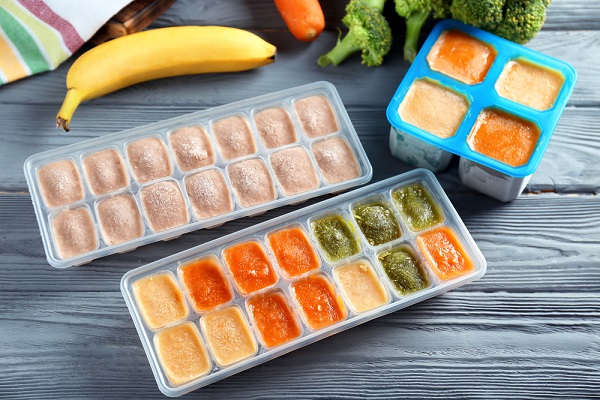How to make fruit and vegetable purées for baby
Baby’s first foods need to be rich in iron, like fortified cereals for babies or some purées made with protein-rich foods. You can start offering the foods of your choice when baby starts eating these twice a day. That is when you can start introducing vegetables and fruits.
Here are simple, quick and low-cost ways to make vegetable or fruit purées for your baby.
Vegetable purées
Sweet potatoes, squash, carrots, corn, peas, broccoli, cauliflower, rutabagas and several other vegetables are all perfect for making baby purées. Start introducing foods a single vegetable at a time. You can start feeding mixed foods (ex. beef and broccoli) once your baby is used to a variety of foods.
Directions
- Wash the vegetable under running water. Peel if needed.
- Cut it into pieces.
- Steam the vegetable until you can easily stick a fork in it.
- Purée using a fork, a pestle, a food processor or a blender. If the purée is too thick, you can add a bit of the cooking water.
Nitrates in vegetables?
In the past, it was recommended that parents wait before introducing certain vegetables that are naturally rich in nitrates, like carrots, beets, turnips and spinach. Parents were also advised not to use the cooking water, especially water used to cook carrots, when making purées for their baby.
It’s true that nitrates can cause health problems in very young babies. However, you don’t need to worry about nitrates in vegetables if:
- you serve them once your baby is 6 months old, not before
- you feed your baby a variety of vegetables
(Source: INSPQ, From Tiny Tot to Toddler: A Practical Guide for Parents from Pregnancy to Age Two)
Fruit purées (cooked fruit)
Apples, pears, peaches and plums are all fruits you can purée or stew.
Directions
- Wash and rinse the fruit under running water. Peel and remove the pit or seeds if needed.
- Cut the fruit into pieces.
- Steam or cook in the microwave until you can easily stick a fork in it.
- Purée using a fork, a pestle, a food processor or a blender. If the purée is too thick, you can add a bit of the cooking water.
Using the microwave
Food often doesn’t cook evenly in the microwave. This is why it’s important to thoroughly mix the food and check the temperature before feeding it to your baby. This will prevent burns!
Fruit purée (raw fruit)
Bananas, watermelon, mangos and avocados make excellent purées and don’t need to be cooked. Practical for a quick-made snack!
Directions
- Wash the fruit under running water. Peel and remove the pit or seeds if needed.
- Purée with a fork, a pestle, a food processor or a blender.
Freezing purées
Immediately after preparing the purée:
- Spoon into ice trays and cover.
- Place in the refrigerator to cool.
- Once cool, put in the freezer for 8 to 12 hours.
- Remove the cubes from the tray and place in a freezer bag.
- Write the name of the food and the date on which you made it on the bag.
- Remove any air from the bag and seal tightly. Put back into the freezer.

How long purées can be kept
| In the fridge | In the freezer | |
| Vegetables and fruits | 2 – 3 days | 2 – 3 months |
(Source: INSPQ, From Tiny Tot to Toddler: A Practical Guide for Parents from Pregnancy to Age Two)
